|
|
|
Sort Order |
|
|
|
Items / Page
|
|
|
|
|
|
|
| Srl | Item |
| 1 |
ID:
166718
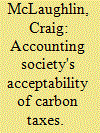

|
|
|
|
|
| Summary/Abstract |
This article seeks to examine accountants' perceptions of carbon taxes in addressing climate change. Specifically, it aims at (i) a better understanding of accountants opinions on carbon taxes; (ii) how energy companies have adapted their business operations since introducing carbon tax. The article's primary sources of data are (1) a 2018 survey distributed to 45 accounting professionals in Scotland, which specialise in energy finance and a formal interview with a regional finance director of a multinational energy company. The results show how the accountants are in favour the carbon tax due to its positive environmental impact, however, do not agree with the associated rising utility costs. Though, carbon tax, from an energy business' perspective, is viewed negatively due to its effects on the end users of energy. This study contributes to the current research by demonstrating the role of accounting society in boosting public awareness of climate change. The findings of this study will help regulators and policy makers in the UK to evaluate the adequacy of current carbon tax reforms and to promote the public awareness of climate change to reduce carbon emissions.
|
|
|
|
|
|
|
|
|
|
|
|
|
|
|
|
| 2 |
ID:
169747
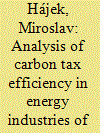

|
|
|
|
|
| Summary/Abstract |
A carbon tax is one of economic policy instruments of environmental protection supposed to contribute to the reduction of greenhouse gas (GHG) emissions. A functional carbon tax aims at incorporating costs for elimination of environmental harm into the pricing decisions. In terms of global climate change, the carbon tax is usually imposed on the production, distribution or consumption of carbon-content fossil fuels. The main aim of the study is to evaluate the carbon tax environmental effectiveness in the energy industries of selected EU countries, namely Sweden, Finland, Denmark, Ireland and Slovenia. To achieve the principal research objective, the multiple panel regression method for the selected variables was used, the synergy of other environmental policy tools being taken into account. Control variables employed were emission allowance price, household final consumption expenditure, corporate investments, solid fuel consumption and renewable energy consumption. The analysis results suggest that the carbon tax in the energy industry is environmentally efficient, an increased tax rate allowing to reduce GHG production, which is statistically significantly affected by the consumption of fossil fuels. Based on the estimated partial regression coefficient (−0.01158), raising the carbon tax by one euro per tonne can cut annual per capita emissions by 11.58 kg.
|
|
|
|
|
|
|
|
|
|
|
|
|
|
|
|
| 3 |
ID:
107495
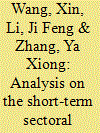

|
|
|
|
|
| Publication |
2011.
|
| Summary/Abstract |
Market-based instruments, particularly carbon tax, have recently drawn the attention of Chinese government by their cost-effective contribution to the achievement of China's climate targets. Most of the recent policy proposals have focused on its long-term impact. However, particularly for policy makers, both long term and short term effects of carbon tax would be necessary when determining tax rates. We provided a detailed analysis of short-term impacts of carbon tax on sectoral competitiveness in this paper. We divided China's economy into 36 sectors, based on its 2007 input-output table, in order to examine the ratio of carbon tax added costs to sector GDP. We were thus able to determine the impact level of a carbon tax on each sector. We then divided the sectoral trade impact into domestic competitiveness with regards to foreign imported products and international competitiveness external to the Chinese domestic market. We found that a high tax level (100 yuan/t CO2) may necessitate compensatory measures to certain highly affected industries, and that a low tax rate (10 yuan/t CO2) would generate few competitiveness problems for all industries and may therefore be considered as an appropriate starting point.
|
|
|
|
|
|
|
|
|
|
|
|
|
|
|
|
| 4 |
ID:
171511
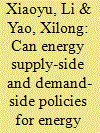

|
|
|
|
|
| Summary/Abstract |
Existing literature mainly focuses on the combined effect of different policies on energy, economy and environment. However, most of them were based on the perspective of energy demand-side. In order to fill this gap, we study the effect of carbon tax and coal capacity cut from both the energy demand-side and energy supply-side using a dynamic Computable General Equilibrium (CGE) model. Different policy effects including single one and synergistic one are compared. Moreover, the synergy degrees of coal capacity cut and carbon tax in energy saving, emission reduction and economic growth are evaluated. The results show that both coal capacity cut and carbon tax are beneficial to energy conservation and carbon emission mitigation at the expense of a slight loss in economy. Mixed policy has better performance than single policy in carbon emission reduction and energy saving. Also, a more stringent policy is conducive to carbon emission mitigation and energy conservation. Additionally, there are significant synergistic effect of coal capacity cut and carbon tax from the perspectives of energy saving, emission reduction and economic growth. Therefore, the mixed policy of coal capacity cut and carbon tax should be promoted and an appropriate stringency level of policy mix should be adopted.
|
|
|
|
|
|
|
|
|
|
|
|
|
|
|
|
| 5 |
ID:
128340
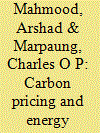

|
|
|
|
|
| Publication |
2014.
|
| Summary/Abstract |
Carbon/energy taxes and energy efficiency improvement are studied well in the recent years for their potential adverse impacts on economy, especially for lost production and international competitiveness, and rebound effects. However, little attention has been paid to investigate them jointly, which can not only prevent fall of energy services cost and thereby rebound effect but reduce the associated macroeconomic costs. This study thus employs a 20 sector CGE model to explore separately the impacts of carbon tax and its coordinated implementation with energy efficiency improvement on the Pakistan economy. The country underwent enormous pressure of energy security issues as well as climate change fallouts in the last couple of years and can be regarded as a suitable candidate for energy/environmental conservation policies to be considered at a broader context with more concrete efforts. The simulation results show that the impact of carbon tax on GDP is negative but resulting reductions in pollutant emissions are relatively high. Moreover, the GDP is expected to grow comparatively positive when analyzed with improvements in energy efficiency, with even higher decline in energy consumption demand and so emissions. This simultaneous economic and environmental improvement would thus have positive implications regarding sustainable development of the country.
|
|
|
|
|
|
|
|
|
|
|
|
|
|
|
|
| 6 |
ID:
150055


|
|
|
|
|
| Summary/Abstract |
This paper studies various options to support allowance prices in the EU Emissions Trading System (ETS), such as adjusting the cap, an auction reserve price, and fixed and variable carbon taxes in addition to the EU ETS. We use a dynamic computable general equilibrium model that explicitly allows for allowance banking and for a detailed cost-effectiveness analysis at the EU Member State level. We find that tightening the cap provides an ad hoc solution to the fundamental issue of the robustness of the effective carbon price, while introducing a price component to the ETS brings structural carbon price support in times of negative demand shocks for emission allowances. These price-based policies still benefit from the intertemporal flexibility through the banking provision in the EU ETS by re-allocating emissions over time with stronger emission reductions in early years and emission increases in later years. A higher emission price has a larger negative impact on the new Member States' economies than on other Member States. Furthermore, introducing a carbon tax in addition to the EU ETS decreases the price of allowances, resulting in welfare gains for net buyers of allowances while net sellers are worse off.
|
|
|
|
|
|
|
|
|
|
|
|
|
|
|
|
| 7 |
ID:
176707
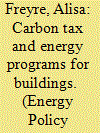

|
|
|
|
|
| Summary/Abstract |
Carbon tax is among the most intensively discussed topics in energy research and policy nowadays, but the question of using carbon tax revenue for environmental and energy policy purposes has received little attention so far. Currently the revenue generated from carbon tax has different usage in the countries worldwide, with only one quarter used for environmental and sustainable energy purposes. Against this background we study whether it can be advisable to use carbon tax revenue for financing energy efficiency and renewable energy (EERE) programs. Based on the case study of Switzerland, we demonstrate that such a policy approach could not only allow to achieve additional reduction of CO2 emissions, but also considerable net benefits to household sector with regard to reduction of heating costs, while having rather low program costs for individual households.
|
|
|
|
|
|
|
|
|
|
|
|
|
|
|
|
| 8 |
ID:
179713
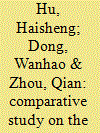

|
|
|
|
|
| Summary/Abstract |
This paper is a comparative study on the effects of a resource tax and a carbon tax. In this paper, we use the computable general equilibrium (CGE) approach to simulate the impact of China's increasing resource tax rate policy and carbon tax policy. The strengths and weaknesses of the two policies are compared from the perspective of energy utilization, air emissions, the macro economy, government tax revenue, household income, and enterprise net profit. A carbon tax leads to a reduction of all kinds of energy consumption. A carbon tax of 1 yuan/ton of CO2 can reduce CO2 emissions by 2100 tons and significantly reduce SO2, NOx, PM2.5, and PM10 emissions. From the perspective of energy utilization, carbon emissions, and pollutant emissions, the effect of a carbon tax is significantly better than that of a resource tax. If the rate of a resource tax rises by 50%, or a carbon tax is levied at the rate of 4 yuan/ton of CO2, China's economy (on a GDP basis) will decline by 0.1%.
|
|
|
|
|
|
|
|
|
|
|
|
|
|
|
|
| 9 |
ID:
175005
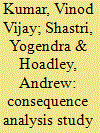

|
|
|
|
|
| Summary/Abstract |
Natural gas, as the cleanest burning of the fossil fuels is expected to play a significant role in India's future energy mix. This paper presents a modelling approach to quantify the economic and environmental impacts of natural gas utilisation by various sectors in India while the production of domestically sourced natural gas is in decline. One of the most important sectors is the use of natural gas for cooking where the benefits are also evaluated. The long-term impacts of a reducing domestic gas supply is assessed by using the resource-substitution methodology along with a dynamic resource-depletion indicator that is based on decision-making viewpoints. The results show that the replacement of domestic gas with black coal resulted in an increase under the climate change category by 162%, 202% and 234% for the individualist, hierarchist and egalitarian viewpoints, respectively. The paper highlights the prospects for natural gas in India and shows that the growing demand for gas can be met through imports, but it has associated economic and environmental impacts. Further, the paper presents suitable recommendations including policy-related changes such as carbon pricing and subsidy provision schemes to ensure that the growth of the Indian gas market is sustainable.
|
|
|
|
|
|
|
|
|
|
|
|
|
|
|
|
| 10 |
ID:
094951
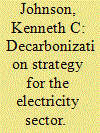

|
|
|
|
|
| Publication |
2010.
|
| Summary/Abstract |
An expedient phase-out of carbon emissions in the electricity sector could be facilitated by imposing carbon fees and applying the revenue exclusively to subsidize new, low-carbon generation sources. Since there would initially be no "new sources," fees would be substantially zero at the outset of the program. Nevertheless, the program would immediately create high price incentives for low-carbon capacity expansion. Fees would increase as new, low-carbon sources gain market share, but price competition from a growing, subsidized clean-energy industry would help maintain moderate retail electricity prices. Subsidies would automatically phase out as emitting sources become obsolete.
|
|
|
|
|
|
|
|
|
|
|
|
|
|
|
|
| 11 |
ID:
121038
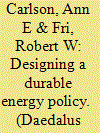

|
|
|
|
|
| Publication |
2013.
|
| Summary/Abstract |
Although the U.S. energy system seems to resist the changes necessary to meet today's challenges related to energy security and climate change, the system has gone through massive change several times since 1850. A major driver in each of these earlier transitions was an economic value, such as mobility, that markets could capture. Because environmental and security values are public goods, changing today's energy system will require a policy that creates a market signal reflecting these values. However, it is also necessary to craft a policy framework that is both durable over a long time period and able to adapt to new information as it becomes available. This essay examines some of the possible attributes of a durable and adaptable policy. The discussion is necessarily preliminary because relatively little formal research exists on this topic. However, even a preliminary examination suggests that considerations of policy durability could affect the choice between a carbon tax and a cap-and-trade system.
|
|
|
|
|
|
|
|
|
|
|
|
|
|
|
|
| 12 |
ID:
176763
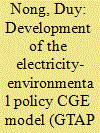

|
|
|
|
|
| Summary/Abstract |
A new carbon price mechanism with full emission coverage is developed within the framework of a global computable general equilibrium model (GTAP-E-PowerS) to enhance the capacity and accuracy for climate change and energy policy assessment. The model developed is then used to examine the potential impacts of the carbon tax in South Africa. Results show that incorporation of non-CO2 emissions in the model significantly alters the results of which the economy of South Africa experiences higher costs compared to the case that only has CO2 emissions. When more sectors are included in the policy it also puts higher costs on the economy, as higher levels of emissions are subject to the carbon tax. Results also show that South Africa only experiences small tradeoffs from introducing the carbon tax in all scenarios. That is, with a tax rate of $9.15, the country is able to reduce its emission levels by 12.25%–15.6% at the costs of real GDP reduction by 1.17%–1.59%. Fossil-based industrial sectors are particularly worst off, while clean and renewable energy sectors strongly expand their production. The results indicate that South Africa is likely to move to a low carbon and sustainable economy with such a policy.
|
|
|
|
|
|
|
|
|
|
|
|
|
|
|
|
| 13 |
ID:
171425
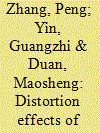

|
|
|
|
|
| Summary/Abstract |
Emissions Trading System (ETS) only regulates above-threshold emission sources in the covered sectors due of administrative costs consideration. Due to differentiated cost burdens on regulated- and unregulated-emission sources, ETS may give rise to intra-sector competition distortion and carbon leakage within a regulated sector. For developing countries where the industrial concentration is relatively low, such defects are more significant since unregulated emission sources as a whole accounts for an unneglectable portion of the regulated emission sectors' total production capacity and emissions. By applying a theoretical model, we conclude that unintended transfer payment from regulated emission sources' capital factor to unregulated emission sources’ labor factor causes intra-sector competition distortion. We find that the labor factor cost within a regulated sector remains homogeneous, while the homogeneity of capital factor cost is broken by ETS, causing unintended transfer payment. We have developed the I-SEE (Intra-Sector Equilibrium Evaluation) model to quantitatively assess the intra-sector effect caused by ETS. We suggest that sufficient attention should be paid to balancing the environmental costs borne by regulated and unregulated emission sources in ETS design to avoid unintended transfer payment. A properly designed carbon tax can help correct the intra-sector distortion caused by ETS.
|
|
|
|
|
|
|
|
|
|
|
|
|
|
|
|
| 14 |
ID:
162902
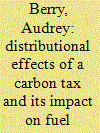

|
|
|
|
|
| Summary/Abstract |
This paper studies the distributional effects of France's recently introduced carbon tax. Using a microsimulation model built on a representative sample of the French population from 2012, it simulates the taxes levied on each household's consumption of energy for housing and transport. Without revenue recycling, the carbon tax is regressive and increases fuel poverty. From a policy perspective, this finding indicates that the question of fuel poverty cannot be ignored in the quest for a fair ecological transition. It proposes that some of the revenues from the carbon tax should be redistributed to households. Different designs of cash transfer to support households are then compared. The results show that the inequities of the carbon tax could be offset at reasonable cost relative to total carbon tax revenues. However, adjusting the design of cash transfers to criteria other than income level does not diminish the cost of compensating households. The benefits of finely adjusting cash transfers may therefore be somewhat limited. Most notably, the results show that targeting revenue recycling at low-income households would help to reduce fuel poverty substantially. This study therefore indicates that carbon taxation actually provides an opportunity to finance ambitious policies to fight fuel poverty.
|
|
|
|
|
|
|
|
|
|
|
|
|
|
|
|
| 15 |
ID:
127913
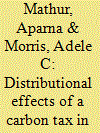

|
|
|
|
|
| Publication |
2014.
|
| Summary/Abstract |
This paper analyzes the distributional implications of an illustrative $15 carbon tax imposed in 2010 on carbon in fossil fuels. We analyze its incidence across income classes and regions, both in isolation and when combined with measures that apply the carbon tax revenue to lowering other distortionary taxes in the economy. Consistent with earlier findings, we find that a carbon tax is regressive. Using tax swap simulations, we then subtract the burden of other taxes the carbon tax revenue could displace, and compute the net effect on households under three assumptions about how capital and labor income might be distributed.
|
|
|
|
|
|
|
|
|
|
|
|
|
|
|
|
| 16 |
ID:
183053
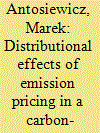

|
|
|
|
|
| Summary/Abstract |
We assess the distributional impact of introducing a carbon tax in a small open economy, using the case of Poland. We use a dynamic general equilibrium model with a search mechanism in the labour market, soft-linked to a microsimulation model based on household budget survey data. We evaluate the impact on various income groups and on inequality. We account for four key channels: the direct (energy) and indirect (other goods) price effects, behavioural adjustment of consumption, and changes in labour income. We consider three of ways to recycle the carbon tax revenue: lump-sum transfer, energy price subsidies, and labour tax reduction. We find that the distributional effects depend on the recycling of revenues. Using them to reduce labor taxation attenuates the negative effect of carbon tax on GDP and employment but increases inequality compared to a lump-sum transfer to households. This finding highlights the trade-off between efficiency and equity. Our results could be relevant for other countries producing fossil fuels, such as South Africa, Germany, or Australia.
|
|
|
|
|
|
|
|
|
|
|
|
|
|
|
|
| 17 |
ID:
177310
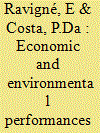

|
|
|
|
|
| Summary/Abstract |
Road transport is a major CO2 emitter that can be reduced by using alternative fuels. This paper offers a micro-simulation of the adoption of compressed natural gas in heavy-duty vehicles based on real French data on industrial flows in 2018 from the automotive manufacturer Renault. Our purpose is to assess the potential of natural gas as a transition fuel for the supply chain by determining the economic conditions under which natural gas is both economically and environmentally beneficial.
|
|
|
|
|
|
|
|
|
|
|
|
|
|
|
|
| 18 |
ID:
144819
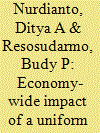

|
|
|
|
|
| Summary/Abstract |
The main goal of this study is to analyse the benefits and losses associated with cooperation among ASEAN members in mitigating their CO2 emissions, particularly by implementing a uniform carbon tax across ASEAN. To achieve this goal, this paper uses a multi-country computable generals equilibrium model for ASEAN, known as the Inter-Regional System of Analysis for ASEAN model. This study finds that the implementation of a carbon tax scenario is an effective means of reducing carbon emissions in the region. However, this environmental gain could come at a cost in terms of GDP contraction and reduction in social welfare, i.e. household income. Nevertheless, Indonesia and Malaysia can potentially gain from the implementation of a carbon tax as it counteracts price distortions due to the existence of heavy energy subsidies in these two countries.
|
|
|
|
|
|
|
|
|
|
|
|
|
|
|
|
| 19 |
ID:
109368
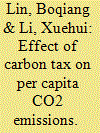

|
|
|
|
|
| Publication |
2011.
|
| Summary/Abstract |
As the most efficient market-based mitigation instrument, carbon tax is highly recommended by economists and international organizations. Countries like Denmark, Finland, Sweden, Netherlands and Norway were the first adopters of carbon tax and as such, research on the impacts and problems of carbon tax implementation in these countries will provide great practical significance as well as caution for countries that are to levy the tax. Different from the existing studies that adopt the model simulation approaches, in this article, we comprehensively estimate the real mitigation effects of the five north European countries by employing the method of difference-in-difference (DID). The results indicate that carbon tax in Finland imposes a significant and negative impact on the growth of its per capita CO2 emissions. Meanwhile, the effects of carbon tax in Denmark, Sweden and Netherlands are negative but not significant. The mitigation effects of carbon tax are weakened due to the tax exemption policies on certain energy intensive industries in these countries. Notwithstanding, in Norway, as the rapid growth of energy products drives a substantial increase of CO2 emissions in oil drilling and natural gas exploitation sectors, carbon tax actually has not realized its mitigation effects.
|
|
|
|
|
|
|
|
|
|
|
|
|
|
|
|
| 20 |
ID:
176116
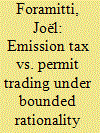

|
|
|
|
|
| Summary/Abstract |
A price on emissions can be achieved through an emission tax or permit trading. The advantages and drawbacks of either instrument are debated. We present an agent-based model to compare their performance under bounded rationality and dynamic markets. It describes firms that face uncertainty about future demand and prices; use heuristic rules to decide production levels, trading prices, and technology adoption; and are heterogeneous in terms of production factors, abatement costs, and trading behavior. Using multiple evaluation criteria and a wide range of parameter values, we find that the main difference between the two policies lies in the fact that permit prices fall after successful abatement. This can lead to higher production levels under permit trading, but can also drive emission-efficient firms out of the market. Scarcity rents under permit trading can further create higher profit rates for firms, the extent of which is shown to depend on the mechanisms for market-clearing and initial allocation.
|
|
|
|
|
|
|
|
|
|
|
|
|
|
|
|
|
|
|
|
|